MBA Business Development: An Integrated Case Study of Petronas
VerifiedAdded on 2023/06/15
|63
|18207
|155
Case Study
AI Summary
This case study provides an in-depth analysis of Petronas, Malaysia's national oil and gas company, focusing on its business development strategies in the face of fluctuating oil prices and market challenges. It covers the company's background, market position, competitive environment, and strategic initiatives. The study includes a business review, examining market size, customer segments, competitor analysis, and market share projections. It also incorporates Porter's Five Forces and PESTEL analysis to assess the external factors impacting Petronas. Furthermore, the research design and data analysis sections detail the methodologies used to evaluate the company's performance and business implications. The case study concludes with recommendations for future strategic growth, organizational structure, and financial planning, including financial statements and key result areas. This document will be helpful to students looking for solved assignments and past papers and is available on Desklib.
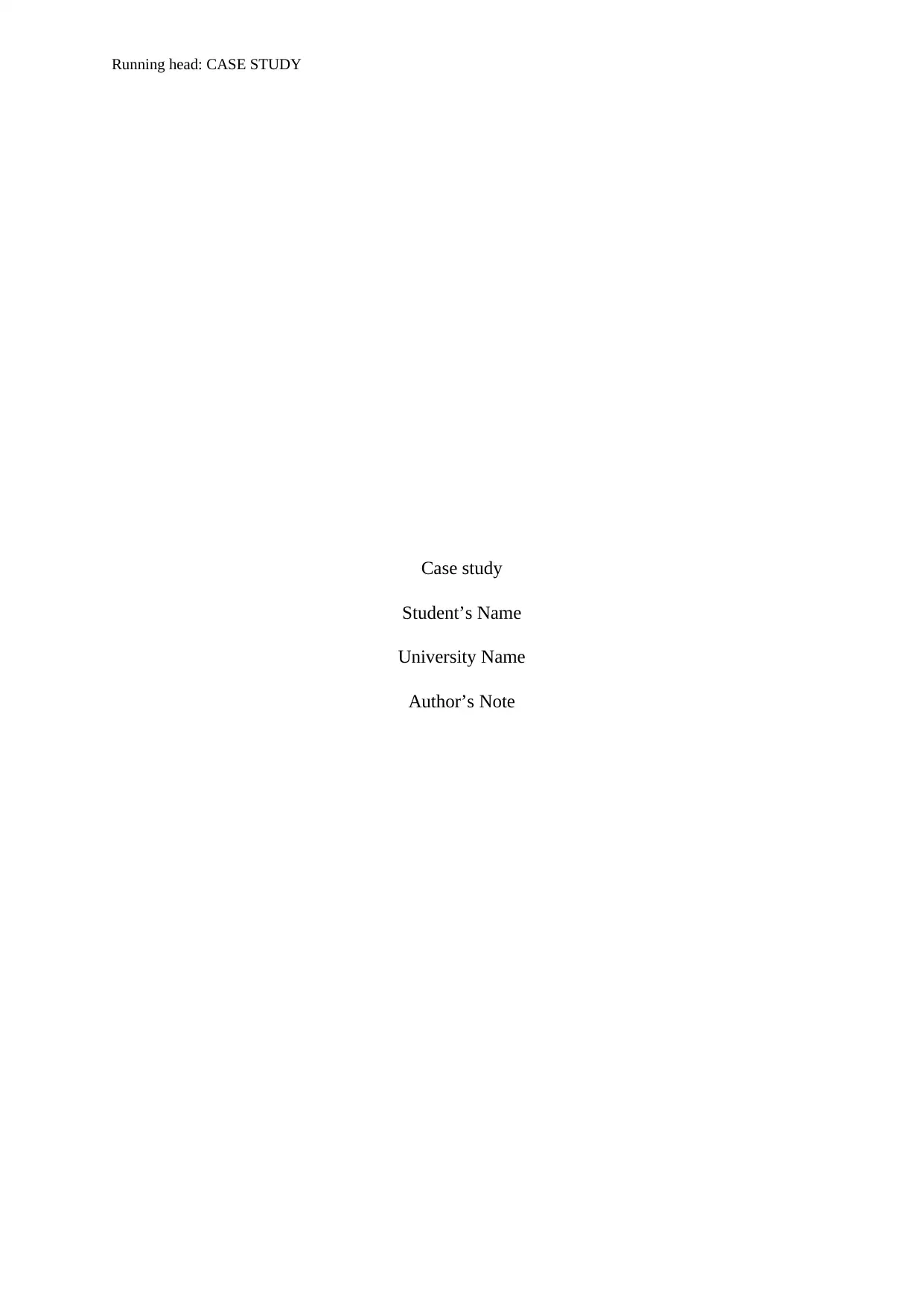
Running head: CASE STUDY
Case study
Student’s Name
University Name
Author’s Note
Case study
Student’s Name
University Name
Author’s Note
Paraphrase This Document
Need a fresh take? Get an instant paraphrase of this document with our AI Paraphraser
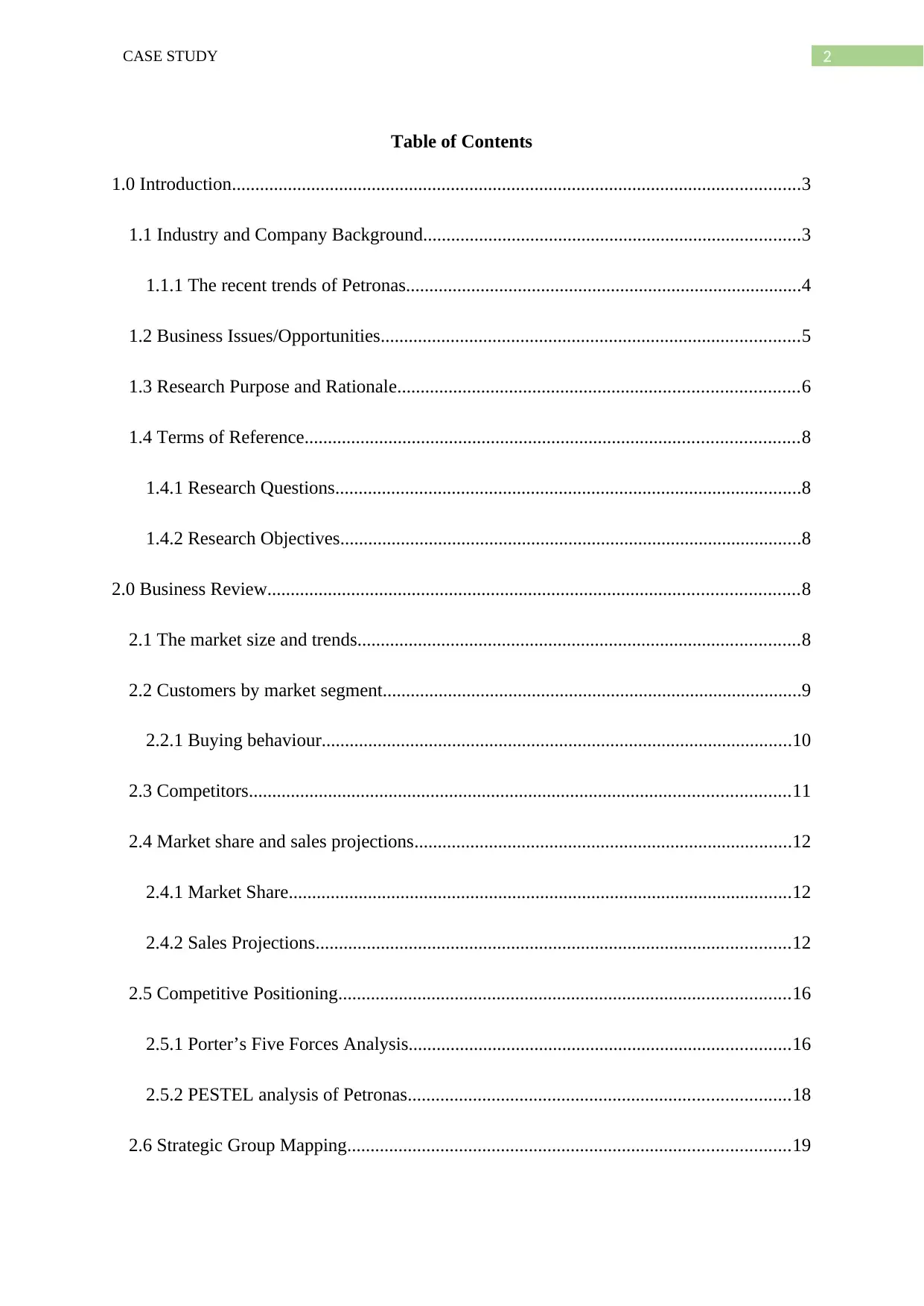
2CASE STUDY
Table of Contents
1.0 Introduction..........................................................................................................................3
1.1 Industry and Company Background.................................................................................3
1.1.1 The recent trends of Petronas.....................................................................................4
1.2 Business Issues/Opportunities..........................................................................................5
1.3 Research Purpose and Rationale......................................................................................6
1.4 Terms of Reference..........................................................................................................8
1.4.1 Research Questions....................................................................................................8
1.4.2 Research Objectives...................................................................................................8
2.0 Business Review..................................................................................................................8
2.1 The market size and trends...............................................................................................8
2.2 Customers by market segment..........................................................................................9
2.2.1 Buying behaviour.....................................................................................................10
2.3 Competitors....................................................................................................................11
2.4 Market share and sales projections.................................................................................12
2.4.1 Market Share............................................................................................................12
2.4.2 Sales Projections......................................................................................................12
2.5 Competitive Positioning.................................................................................................16
2.5.1 Porter’s Five Forces Analysis..................................................................................16
2.5.2 PESTEL analysis of Petronas..................................................................................18
2.6 Strategic Group Mapping...............................................................................................19
Table of Contents
1.0 Introduction..........................................................................................................................3
1.1 Industry and Company Background.................................................................................3
1.1.1 The recent trends of Petronas.....................................................................................4
1.2 Business Issues/Opportunities..........................................................................................5
1.3 Research Purpose and Rationale......................................................................................6
1.4 Terms of Reference..........................................................................................................8
1.4.1 Research Questions....................................................................................................8
1.4.2 Research Objectives...................................................................................................8
2.0 Business Review..................................................................................................................8
2.1 The market size and trends...............................................................................................8
2.2 Customers by market segment..........................................................................................9
2.2.1 Buying behaviour.....................................................................................................10
2.3 Competitors....................................................................................................................11
2.4 Market share and sales projections.................................................................................12
2.4.1 Market Share............................................................................................................12
2.4.2 Sales Projections......................................................................................................12
2.5 Competitive Positioning.................................................................................................16
2.5.1 Porter’s Five Forces Analysis..................................................................................16
2.5.2 PESTEL analysis of Petronas..................................................................................18
2.6 Strategic Group Mapping...............................................................................................19
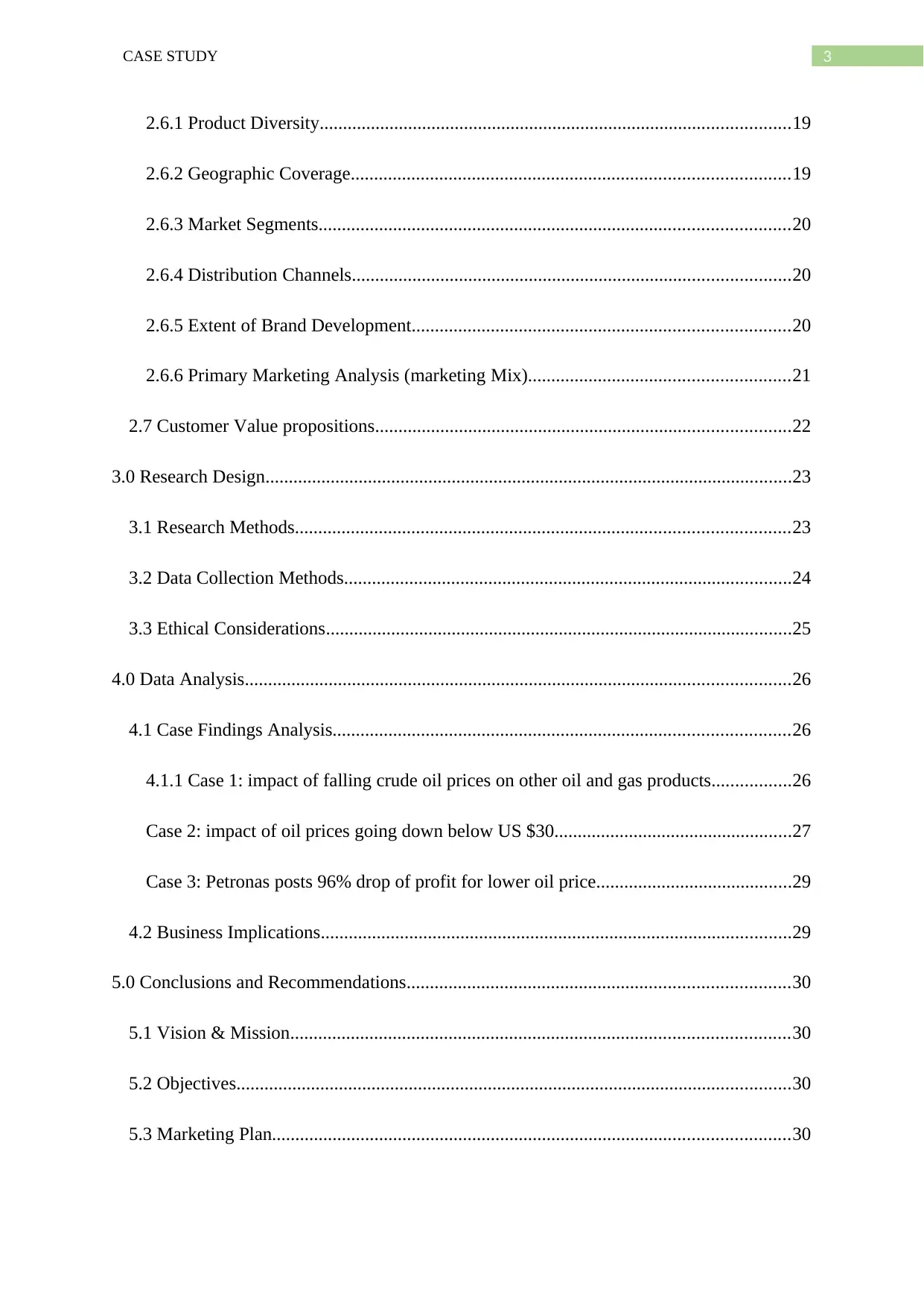
3CASE STUDY
2.6.1 Product Diversity.....................................................................................................19
2.6.2 Geographic Coverage..............................................................................................19
2.6.3 Market Segments.....................................................................................................20
2.6.4 Distribution Channels..............................................................................................20
2.6.5 Extent of Brand Development.................................................................................20
2.6.6 Primary Marketing Analysis (marketing Mix)........................................................21
2.7 Customer Value propositions.........................................................................................22
3.0 Research Design.................................................................................................................23
3.1 Research Methods..........................................................................................................23
3.2 Data Collection Methods................................................................................................24
3.3 Ethical Considerations....................................................................................................25
4.0 Data Analysis.....................................................................................................................26
4.1 Case Findings Analysis..................................................................................................26
4.1.1 Case 1: impact of falling crude oil prices on other oil and gas products.................26
Case 2: impact of oil prices going down below US $30...................................................27
Case 3: Petronas posts 96% drop of profit for lower oil price..........................................29
4.2 Business Implications.....................................................................................................29
5.0 Conclusions and Recommendations..................................................................................30
5.1 Vision & Mission...........................................................................................................30
5.2 Objectives.......................................................................................................................30
5.3 Marketing Plan...............................................................................................................30
2.6.1 Product Diversity.....................................................................................................19
2.6.2 Geographic Coverage..............................................................................................19
2.6.3 Market Segments.....................................................................................................20
2.6.4 Distribution Channels..............................................................................................20
2.6.5 Extent of Brand Development.................................................................................20
2.6.6 Primary Marketing Analysis (marketing Mix)........................................................21
2.7 Customer Value propositions.........................................................................................22
3.0 Research Design.................................................................................................................23
3.1 Research Methods..........................................................................................................23
3.2 Data Collection Methods................................................................................................24
3.3 Ethical Considerations....................................................................................................25
4.0 Data Analysis.....................................................................................................................26
4.1 Case Findings Analysis..................................................................................................26
4.1.1 Case 1: impact of falling crude oil prices on other oil and gas products.................26
Case 2: impact of oil prices going down below US $30...................................................27
Case 3: Petronas posts 96% drop of profit for lower oil price..........................................29
4.2 Business Implications.....................................................................................................29
5.0 Conclusions and Recommendations..................................................................................30
5.1 Vision & Mission...........................................................................................................30
5.2 Objectives.......................................................................................................................30
5.3 Marketing Plan...............................................................................................................30
⊘ This is a preview!⊘
Do you want full access?
Subscribe today to unlock all pages.

Trusted by 1+ million students worldwide
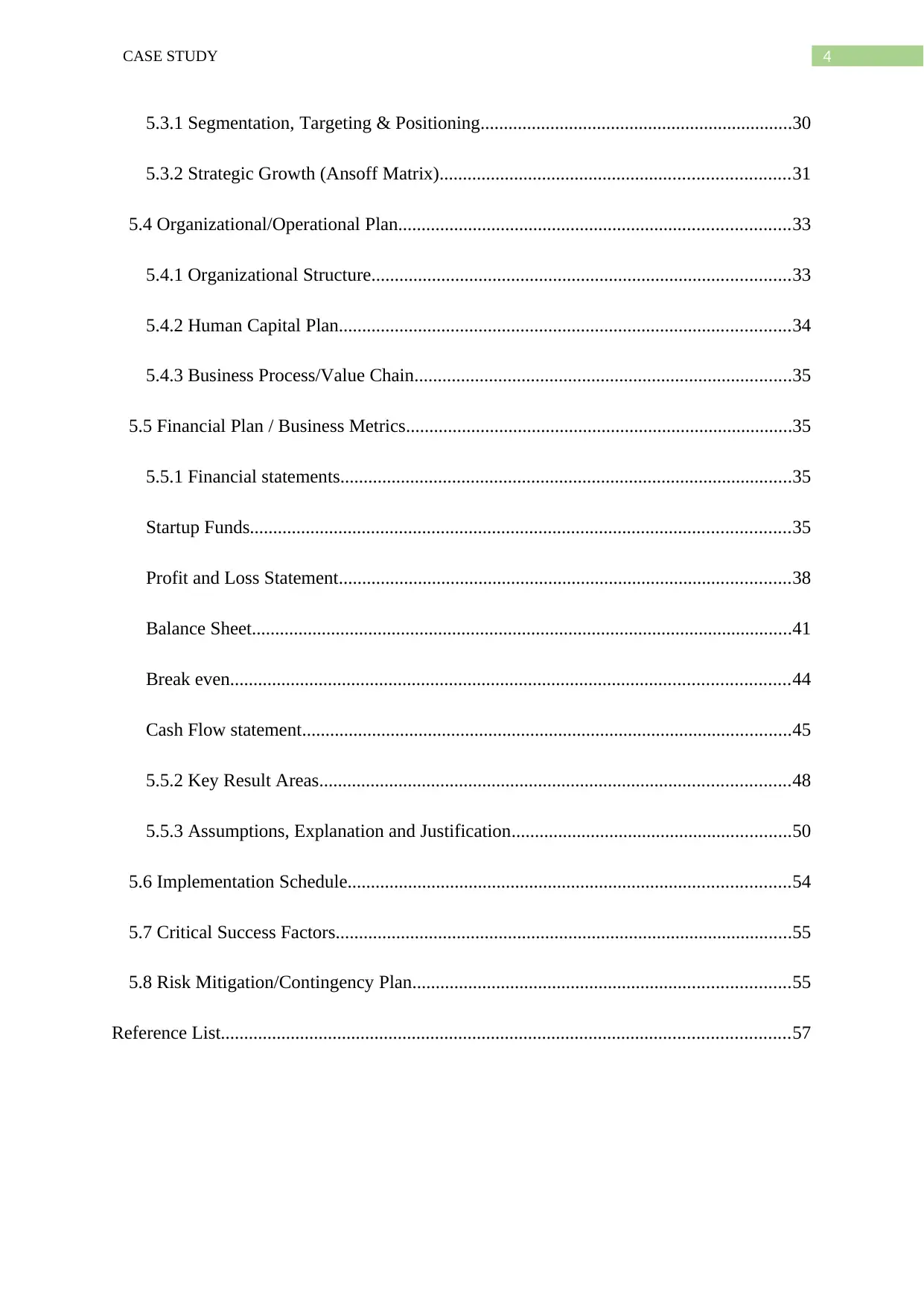
4CASE STUDY
5.3.1 Segmentation, Targeting & Positioning...................................................................30
5.3.2 Strategic Growth (Ansoff Matrix)...........................................................................31
5.4 Organizational/Operational Plan....................................................................................33
5.4.1 Organizational Structure..........................................................................................33
5.4.2 Human Capital Plan.................................................................................................34
5.4.3 Business Process/Value Chain.................................................................................35
5.5 Financial Plan / Business Metrics...................................................................................35
5.5.1 Financial statements.................................................................................................35
Startup Funds....................................................................................................................35
Profit and Loss Statement.................................................................................................38
Balance Sheet....................................................................................................................41
Break even........................................................................................................................44
Cash Flow statement.........................................................................................................45
5.5.2 Key Result Areas.....................................................................................................48
5.5.3 Assumptions, Explanation and Justification............................................................50
5.6 Implementation Schedule...............................................................................................54
5.7 Critical Success Factors..................................................................................................55
5.8 Risk Mitigation/Contingency Plan.................................................................................55
Reference List..........................................................................................................................57
5.3.1 Segmentation, Targeting & Positioning...................................................................30
5.3.2 Strategic Growth (Ansoff Matrix)...........................................................................31
5.4 Organizational/Operational Plan....................................................................................33
5.4.1 Organizational Structure..........................................................................................33
5.4.2 Human Capital Plan.................................................................................................34
5.4.3 Business Process/Value Chain.................................................................................35
5.5 Financial Plan / Business Metrics...................................................................................35
5.5.1 Financial statements.................................................................................................35
Startup Funds....................................................................................................................35
Profit and Loss Statement.................................................................................................38
Balance Sheet....................................................................................................................41
Break even........................................................................................................................44
Cash Flow statement.........................................................................................................45
5.5.2 Key Result Areas.....................................................................................................48
5.5.3 Assumptions, Explanation and Justification............................................................50
5.6 Implementation Schedule...............................................................................................54
5.7 Critical Success Factors..................................................................................................55
5.8 Risk Mitigation/Contingency Plan.................................................................................55
Reference List..........................................................................................................................57
Paraphrase This Document
Need a fresh take? Get an instant paraphrase of this document with our AI Paraphraser
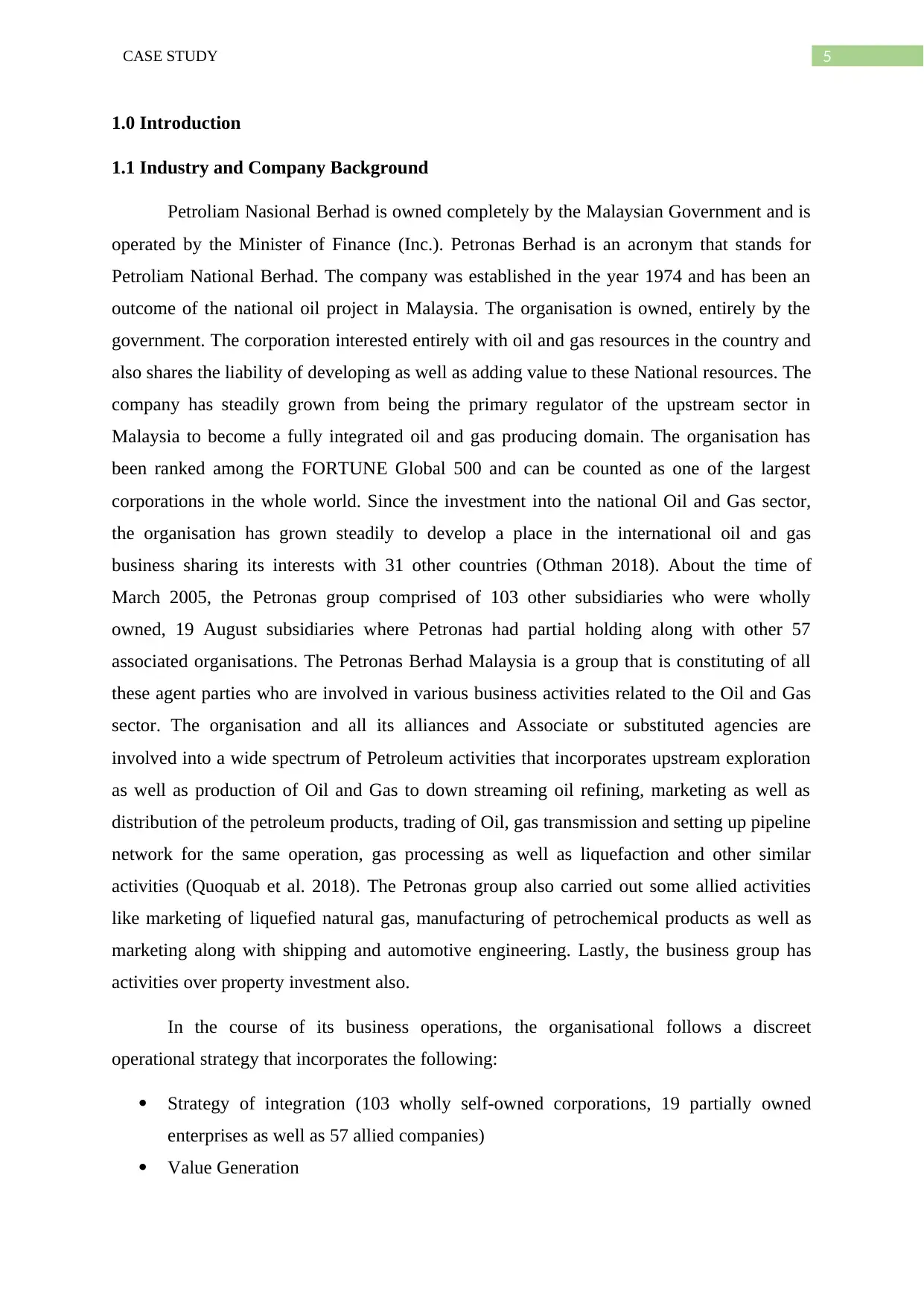
5CASE STUDY
1.0 Introduction
1.1 Industry and Company Background
Petroliam Nasional Berhad is owned completely by the Malaysian Government and is
operated by the Minister of Finance (Inc.). Petronas Berhad is an acronym that stands for
Petroliam National Berhad. The company was established in the year 1974 and has been an
outcome of the national oil project in Malaysia. The organisation is owned, entirely by the
government. The corporation interested entirely with oil and gas resources in the country and
also shares the liability of developing as well as adding value to these National resources. The
company has steadily grown from being the primary regulator of the upstream sector in
Malaysia to become a fully integrated oil and gas producing domain. The organisation has
been ranked among the FORTUNE Global 500 and can be counted as one of the largest
corporations in the whole world. Since the investment into the national Oil and Gas sector,
the organisation has grown steadily to develop a place in the international oil and gas
business sharing its interests with 31 other countries (Othman 2018). About the time of
March 2005, the Petronas group comprised of 103 other subsidiaries who were wholly
owned, 19 August subsidiaries where Petronas had partial holding along with other 57
associated organisations. The Petronas Berhad Malaysia is a group that is constituting of all
these agent parties who are involved in various business activities related to the Oil and Gas
sector. The organisation and all its alliances and Associate or substituted agencies are
involved into a wide spectrum of Petroleum activities that incorporates upstream exploration
as well as production of Oil and Gas to down streaming oil refining, marketing as well as
distribution of the petroleum products, trading of Oil, gas transmission and setting up pipeline
network for the same operation, gas processing as well as liquefaction and other similar
activities (Quoquab et al. 2018). The Petronas group also carried out some allied activities
like marketing of liquefied natural gas, manufacturing of petrochemical products as well as
marketing along with shipping and automotive engineering. Lastly, the business group has
activities over property investment also.
In the course of its business operations, the organisational follows a discreet
operational strategy that incorporates the following:
Strategy of integration (103 wholly self-owned corporations, 19 partially owned
enterprises as well as 57 allied companies)
Value Generation
1.0 Introduction
1.1 Industry and Company Background
Petroliam Nasional Berhad is owned completely by the Malaysian Government and is
operated by the Minister of Finance (Inc.). Petronas Berhad is an acronym that stands for
Petroliam National Berhad. The company was established in the year 1974 and has been an
outcome of the national oil project in Malaysia. The organisation is owned, entirely by the
government. The corporation interested entirely with oil and gas resources in the country and
also shares the liability of developing as well as adding value to these National resources. The
company has steadily grown from being the primary regulator of the upstream sector in
Malaysia to become a fully integrated oil and gas producing domain. The organisation has
been ranked among the FORTUNE Global 500 and can be counted as one of the largest
corporations in the whole world. Since the investment into the national Oil and Gas sector,
the organisation has grown steadily to develop a place in the international oil and gas
business sharing its interests with 31 other countries (Othman 2018). About the time of
March 2005, the Petronas group comprised of 103 other subsidiaries who were wholly
owned, 19 August subsidiaries where Petronas had partial holding along with other 57
associated organisations. The Petronas Berhad Malaysia is a group that is constituting of all
these agent parties who are involved in various business activities related to the Oil and Gas
sector. The organisation and all its alliances and Associate or substituted agencies are
involved into a wide spectrum of Petroleum activities that incorporates upstream exploration
as well as production of Oil and Gas to down streaming oil refining, marketing as well as
distribution of the petroleum products, trading of Oil, gas transmission and setting up pipeline
network for the same operation, gas processing as well as liquefaction and other similar
activities (Quoquab et al. 2018). The Petronas group also carried out some allied activities
like marketing of liquefied natural gas, manufacturing of petrochemical products as well as
marketing along with shipping and automotive engineering. Lastly, the business group has
activities over property investment also.
In the course of its business operations, the organisational follows a discreet
operational strategy that incorporates the following:
Strategy of integration (103 wholly self-owned corporations, 19 partially owned
enterprises as well as 57 allied companies)
Value Generation
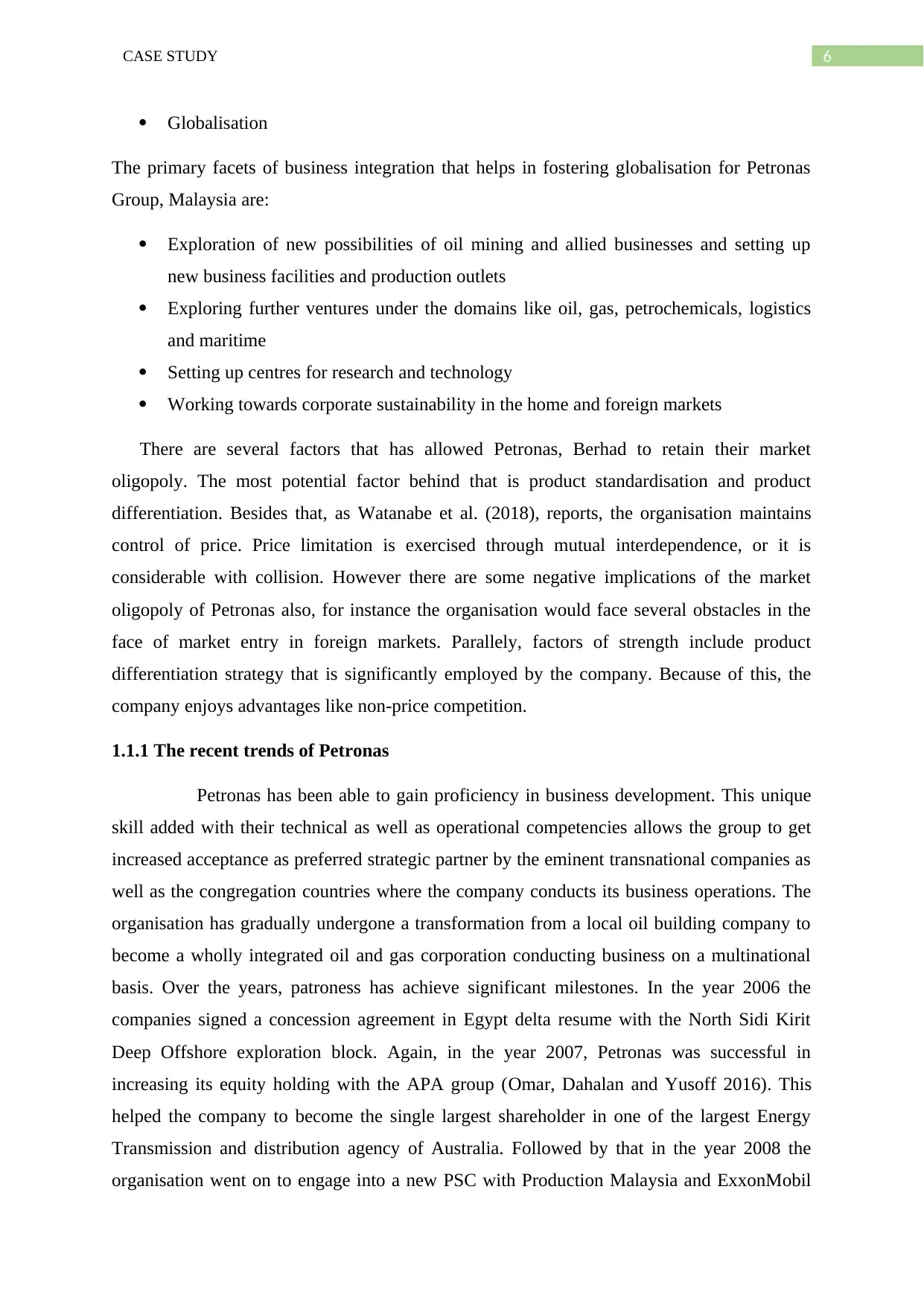
6CASE STUDY
Globalisation
The primary facets of business integration that helps in fostering globalisation for Petronas
Group, Malaysia are:
Exploration of new possibilities of oil mining and allied businesses and setting up
new business facilities and production outlets
Exploring further ventures under the domains like oil, gas, petrochemicals, logistics
and maritime
Setting up centres for research and technology
Working towards corporate sustainability in the home and foreign markets
There are several factors that has allowed Petronas, Berhad to retain their market
oligopoly. The most potential factor behind that is product standardisation and product
differentiation. Besides that, as Watanabe et al. (2018), reports, the organisation maintains
control of price. Price limitation is exercised through mutual interdependence, or it is
considerable with collision. However there are some negative implications of the market
oligopoly of Petronas also, for instance the organisation would face several obstacles in the
face of market entry in foreign markets. Parallely, factors of strength include product
differentiation strategy that is significantly employed by the company. Because of this, the
company enjoys advantages like non-price competition.
1.1.1 The recent trends of Petronas
Petronas has been able to gain proficiency in business development. This unique
skill added with their technical as well as operational competencies allows the group to get
increased acceptance as preferred strategic partner by the eminent transnational companies as
well as the congregation countries where the company conducts its business operations. The
organisation has gradually undergone a transformation from a local oil building company to
become a wholly integrated oil and gas corporation conducting business on a multinational
basis. Over the years, patroness has achieve significant milestones. In the year 2006 the
companies signed a concession agreement in Egypt delta resume with the North Sidi Kirit
Deep Offshore exploration block. Again, in the year 2007, Petronas was successful in
increasing its equity holding with the APA group (Omar, Dahalan and Yusoff 2016). This
helped the company to become the single largest shareholder in one of the largest Energy
Transmission and distribution agency of Australia. Followed by that in the year 2008 the
organisation went on to engage into a new PSC with Production Malaysia and ExxonMobil
Globalisation
The primary facets of business integration that helps in fostering globalisation for Petronas
Group, Malaysia are:
Exploration of new possibilities of oil mining and allied businesses and setting up
new business facilities and production outlets
Exploring further ventures under the domains like oil, gas, petrochemicals, logistics
and maritime
Setting up centres for research and technology
Working towards corporate sustainability in the home and foreign markets
There are several factors that has allowed Petronas, Berhad to retain their market
oligopoly. The most potential factor behind that is product standardisation and product
differentiation. Besides that, as Watanabe et al. (2018), reports, the organisation maintains
control of price. Price limitation is exercised through mutual interdependence, or it is
considerable with collision. However there are some negative implications of the market
oligopoly of Petronas also, for instance the organisation would face several obstacles in the
face of market entry in foreign markets. Parallely, factors of strength include product
differentiation strategy that is significantly employed by the company. Because of this, the
company enjoys advantages like non-price competition.
1.1.1 The recent trends of Petronas
Petronas has been able to gain proficiency in business development. This unique
skill added with their technical as well as operational competencies allows the group to get
increased acceptance as preferred strategic partner by the eminent transnational companies as
well as the congregation countries where the company conducts its business operations. The
organisation has gradually undergone a transformation from a local oil building company to
become a wholly integrated oil and gas corporation conducting business on a multinational
basis. Over the years, patroness has achieve significant milestones. In the year 2006 the
companies signed a concession agreement in Egypt delta resume with the North Sidi Kirit
Deep Offshore exploration block. Again, in the year 2007, Petronas was successful in
increasing its equity holding with the APA group (Omar, Dahalan and Yusoff 2016). This
helped the company to become the single largest shareholder in one of the largest Energy
Transmission and distribution agency of Australia. Followed by that in the year 2008 the
organisation went on to engage into a new PSC with Production Malaysia and ExxonMobil
⊘ This is a preview!⊘
Do you want full access?
Subscribe today to unlock all pages.

Trusted by 1+ million students worldwide
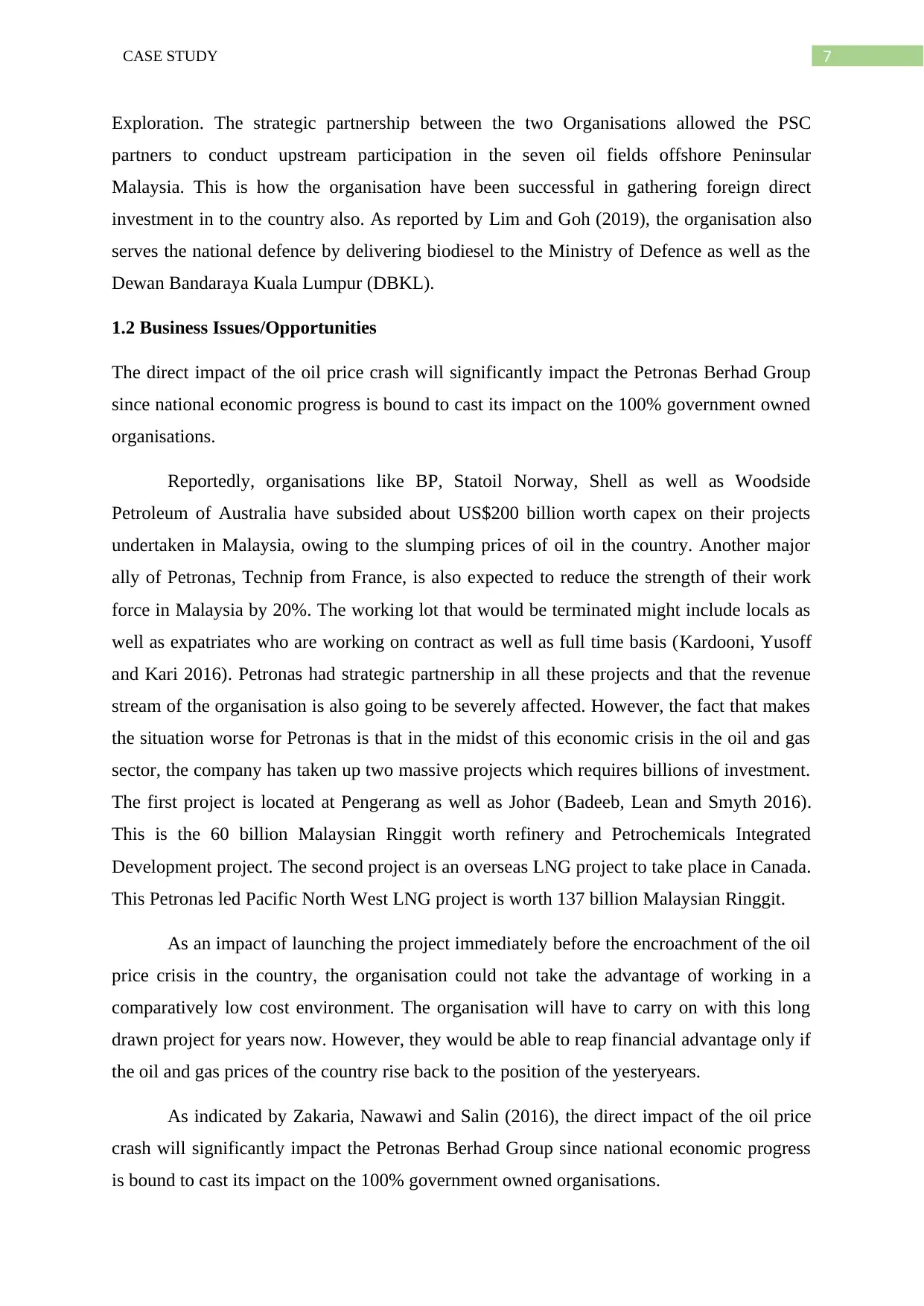
7CASE STUDY
Exploration. The strategic partnership between the two Organisations allowed the PSC
partners to conduct upstream participation in the seven oil fields offshore Peninsular
Malaysia. This is how the organisation have been successful in gathering foreign direct
investment in to the country also. As reported by Lim and Goh (2019), the organisation also
serves the national defence by delivering biodiesel to the Ministry of Defence as well as the
Dewan Bandaraya Kuala Lumpur (DBKL).
1.2 Business Issues/Opportunities
The direct impact of the oil price crash will significantly impact the Petronas Berhad Group
since national economic progress is bound to cast its impact on the 100% government owned
organisations.
Reportedly, organisations like BP, Statoil Norway, Shell as well as Woodside
Petroleum of Australia have subsided about US$200 billion worth capex on their projects
undertaken in Malaysia, owing to the slumping prices of oil in the country. Another major
ally of Petronas, Technip from France, is also expected to reduce the strength of their work
force in Malaysia by 20%. The working lot that would be terminated might include locals as
well as expatriates who are working on contract as well as full time basis (Kardooni, Yusoff
and Kari 2016). Petronas had strategic partnership in all these projects and that the revenue
stream of the organisation is also going to be severely affected. However, the fact that makes
the situation worse for Petronas is that in the midst of this economic crisis in the oil and gas
sector, the company has taken up two massive projects which requires billions of investment.
The first project is located at Pengerang as well as Johor (Badeeb, Lean and Smyth 2016).
This is the 60 billion Malaysian Ringgit worth refinery and Petrochemicals Integrated
Development project. The second project is an overseas LNG project to take place in Canada.
This Petronas led Pacific North West LNG project is worth 137 billion Malaysian Ringgit.
As an impact of launching the project immediately before the encroachment of the oil
price crisis in the country, the organisation could not take the advantage of working in a
comparatively low cost environment. The organisation will have to carry on with this long
drawn project for years now. However, they would be able to reap financial advantage only if
the oil and gas prices of the country rise back to the position of the yesteryears.
As indicated by Zakaria, Nawawi and Salin (2016), the direct impact of the oil price
crash will significantly impact the Petronas Berhad Group since national economic progress
is bound to cast its impact on the 100% government owned organisations.
Exploration. The strategic partnership between the two Organisations allowed the PSC
partners to conduct upstream participation in the seven oil fields offshore Peninsular
Malaysia. This is how the organisation have been successful in gathering foreign direct
investment in to the country also. As reported by Lim and Goh (2019), the organisation also
serves the national defence by delivering biodiesel to the Ministry of Defence as well as the
Dewan Bandaraya Kuala Lumpur (DBKL).
1.2 Business Issues/Opportunities
The direct impact of the oil price crash will significantly impact the Petronas Berhad Group
since national economic progress is bound to cast its impact on the 100% government owned
organisations.
Reportedly, organisations like BP, Statoil Norway, Shell as well as Woodside
Petroleum of Australia have subsided about US$200 billion worth capex on their projects
undertaken in Malaysia, owing to the slumping prices of oil in the country. Another major
ally of Petronas, Technip from France, is also expected to reduce the strength of their work
force in Malaysia by 20%. The working lot that would be terminated might include locals as
well as expatriates who are working on contract as well as full time basis (Kardooni, Yusoff
and Kari 2016). Petronas had strategic partnership in all these projects and that the revenue
stream of the organisation is also going to be severely affected. However, the fact that makes
the situation worse for Petronas is that in the midst of this economic crisis in the oil and gas
sector, the company has taken up two massive projects which requires billions of investment.
The first project is located at Pengerang as well as Johor (Badeeb, Lean and Smyth 2016).
This is the 60 billion Malaysian Ringgit worth refinery and Petrochemicals Integrated
Development project. The second project is an overseas LNG project to take place in Canada.
This Petronas led Pacific North West LNG project is worth 137 billion Malaysian Ringgit.
As an impact of launching the project immediately before the encroachment of the oil
price crisis in the country, the organisation could not take the advantage of working in a
comparatively low cost environment. The organisation will have to carry on with this long
drawn project for years now. However, they would be able to reap financial advantage only if
the oil and gas prices of the country rise back to the position of the yesteryears.
As indicated by Zakaria, Nawawi and Salin (2016), the direct impact of the oil price
crash will significantly impact the Petronas Berhad Group since national economic progress
is bound to cast its impact on the 100% government owned organisations.
Paraphrase This Document
Need a fresh take? Get an instant paraphrase of this document with our AI Paraphraser
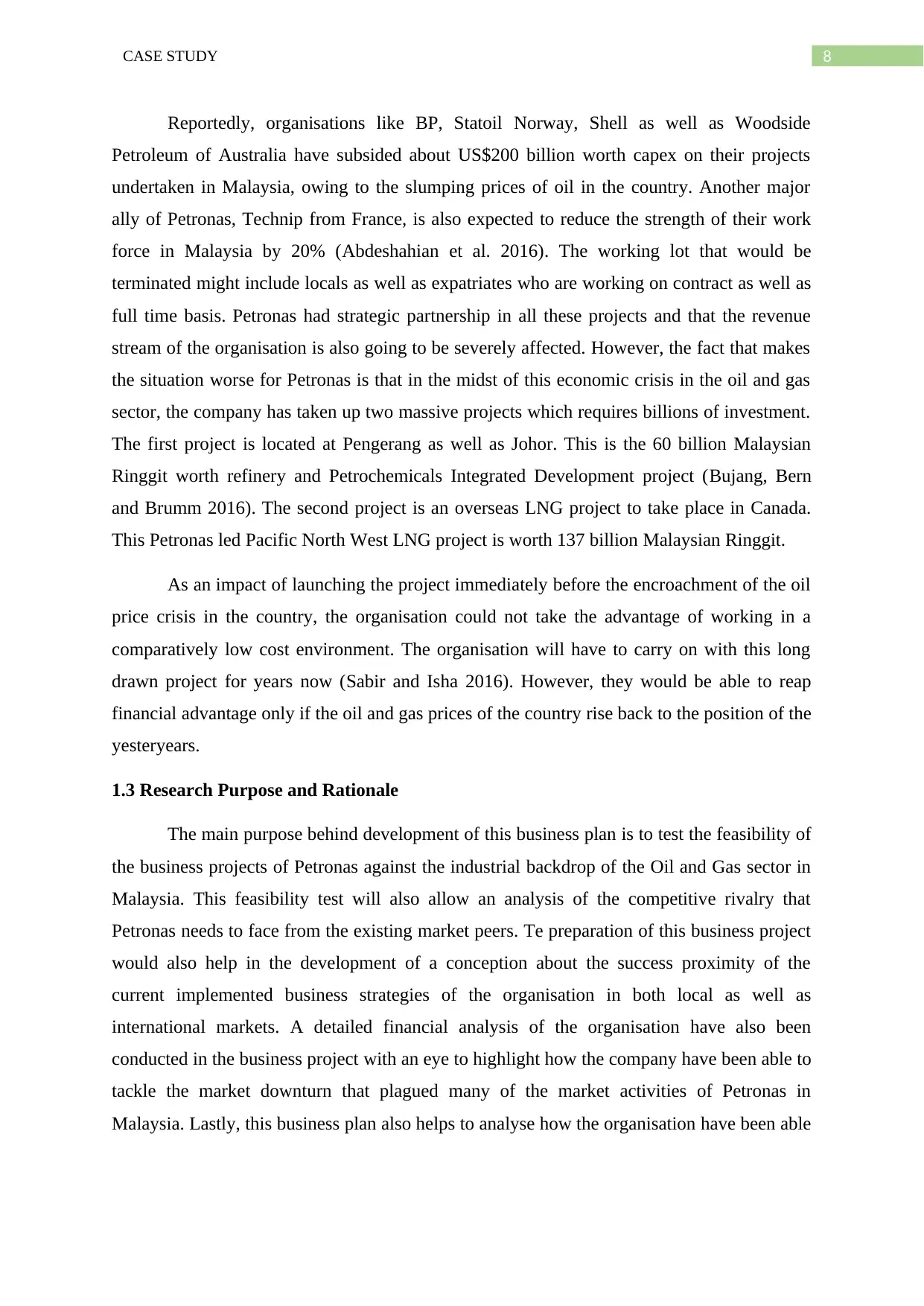
8CASE STUDY
Reportedly, organisations like BP, Statoil Norway, Shell as well as Woodside
Petroleum of Australia have subsided about US$200 billion worth capex on their projects
undertaken in Malaysia, owing to the slumping prices of oil in the country. Another major
ally of Petronas, Technip from France, is also expected to reduce the strength of their work
force in Malaysia by 20% (Abdeshahian et al. 2016). The working lot that would be
terminated might include locals as well as expatriates who are working on contract as well as
full time basis. Petronas had strategic partnership in all these projects and that the revenue
stream of the organisation is also going to be severely affected. However, the fact that makes
the situation worse for Petronas is that in the midst of this economic crisis in the oil and gas
sector, the company has taken up two massive projects which requires billions of investment.
The first project is located at Pengerang as well as Johor. This is the 60 billion Malaysian
Ringgit worth refinery and Petrochemicals Integrated Development project (Bujang, Bern
and Brumm 2016). The second project is an overseas LNG project to take place in Canada.
This Petronas led Pacific North West LNG project is worth 137 billion Malaysian Ringgit.
As an impact of launching the project immediately before the encroachment of the oil
price crisis in the country, the organisation could not take the advantage of working in a
comparatively low cost environment. The organisation will have to carry on with this long
drawn project for years now (Sabir and Isha 2016). However, they would be able to reap
financial advantage only if the oil and gas prices of the country rise back to the position of the
yesteryears.
1.3 Research Purpose and Rationale
The main purpose behind development of this business plan is to test the feasibility of
the business projects of Petronas against the industrial backdrop of the Oil and Gas sector in
Malaysia. This feasibility test will also allow an analysis of the competitive rivalry that
Petronas needs to face from the existing market peers. Te preparation of this business project
would also help in the development of a conception about the success proximity of the
current implemented business strategies of the organisation in both local as well as
international markets. A detailed financial analysis of the organisation have also been
conducted in the business project with an eye to highlight how the company have been able to
tackle the market downturn that plagued many of the market activities of Petronas in
Malaysia. Lastly, this business plan also helps to analyse how the organisation have been able
Reportedly, organisations like BP, Statoil Norway, Shell as well as Woodside
Petroleum of Australia have subsided about US$200 billion worth capex on their projects
undertaken in Malaysia, owing to the slumping prices of oil in the country. Another major
ally of Petronas, Technip from France, is also expected to reduce the strength of their work
force in Malaysia by 20% (Abdeshahian et al. 2016). The working lot that would be
terminated might include locals as well as expatriates who are working on contract as well as
full time basis. Petronas had strategic partnership in all these projects and that the revenue
stream of the organisation is also going to be severely affected. However, the fact that makes
the situation worse for Petronas is that in the midst of this economic crisis in the oil and gas
sector, the company has taken up two massive projects which requires billions of investment.
The first project is located at Pengerang as well as Johor. This is the 60 billion Malaysian
Ringgit worth refinery and Petrochemicals Integrated Development project (Bujang, Bern
and Brumm 2016). The second project is an overseas LNG project to take place in Canada.
This Petronas led Pacific North West LNG project is worth 137 billion Malaysian Ringgit.
As an impact of launching the project immediately before the encroachment of the oil
price crisis in the country, the organisation could not take the advantage of working in a
comparatively low cost environment. The organisation will have to carry on with this long
drawn project for years now (Sabir and Isha 2016). However, they would be able to reap
financial advantage only if the oil and gas prices of the country rise back to the position of the
yesteryears.
1.3 Research Purpose and Rationale
The main purpose behind development of this business plan is to test the feasibility of
the business projects of Petronas against the industrial backdrop of the Oil and Gas sector in
Malaysia. This feasibility test will also allow an analysis of the competitive rivalry that
Petronas needs to face from the existing market peers. Te preparation of this business project
would also help in the development of a conception about the success proximity of the
current implemented business strategies of the organisation in both local as well as
international markets. A detailed financial analysis of the organisation have also been
conducted in the business project with an eye to highlight how the company have been able to
tackle the market downturn that plagued many of the market activities of Petronas in
Malaysia. Lastly, this business plan also helps to analyse how the organisation have been able
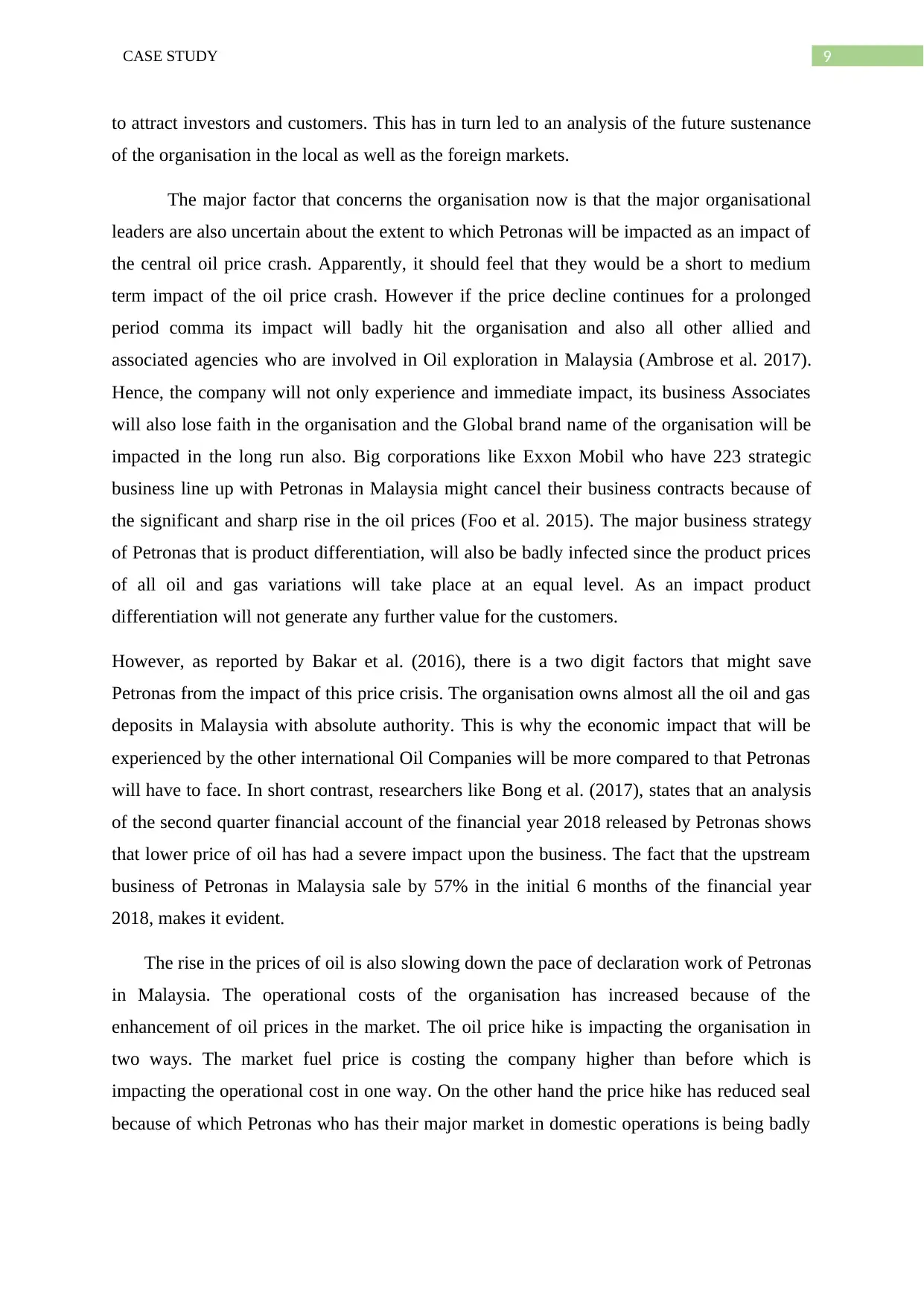
9CASE STUDY
to attract investors and customers. This has in turn led to an analysis of the future sustenance
of the organisation in the local as well as the foreign markets.
The major factor that concerns the organisation now is that the major organisational
leaders are also uncertain about the extent to which Petronas will be impacted as an impact of
the central oil price crash. Apparently, it should feel that they would be a short to medium
term impact of the oil price crash. However if the price decline continues for a prolonged
period comma its impact will badly hit the organisation and also all other allied and
associated agencies who are involved in Oil exploration in Malaysia (Ambrose et al. 2017).
Hence, the company will not only experience and immediate impact, its business Associates
will also lose faith in the organisation and the Global brand name of the organisation will be
impacted in the long run also. Big corporations like Exxon Mobil who have 223 strategic
business line up with Petronas in Malaysia might cancel their business contracts because of
the significant and sharp rise in the oil prices (Foo et al. 2015). The major business strategy
of Petronas that is product differentiation, will also be badly infected since the product prices
of all oil and gas variations will take place at an equal level. As an impact product
differentiation will not generate any further value for the customers.
However, as reported by Bakar et al. (2016), there is a two digit factors that might save
Petronas from the impact of this price crisis. The organisation owns almost all the oil and gas
deposits in Malaysia with absolute authority. This is why the economic impact that will be
experienced by the other international Oil Companies will be more compared to that Petronas
will have to face. In short contrast, researchers like Bong et al. (2017), states that an analysis
of the second quarter financial account of the financial year 2018 released by Petronas shows
that lower price of oil has had a severe impact upon the business. The fact that the upstream
business of Petronas in Malaysia sale by 57% in the initial 6 months of the financial year
2018, makes it evident.
The rise in the prices of oil is also slowing down the pace of declaration work of Petronas
in Malaysia. The operational costs of the organisation has increased because of the
enhancement of oil prices in the market. The oil price hike is impacting the organisation in
two ways. The market fuel price is costing the company higher than before which is
impacting the operational cost in one way. On the other hand the price hike has reduced seal
because of which Petronas who has their major market in domestic operations is being badly
to attract investors and customers. This has in turn led to an analysis of the future sustenance
of the organisation in the local as well as the foreign markets.
The major factor that concerns the organisation now is that the major organisational
leaders are also uncertain about the extent to which Petronas will be impacted as an impact of
the central oil price crash. Apparently, it should feel that they would be a short to medium
term impact of the oil price crash. However if the price decline continues for a prolonged
period comma its impact will badly hit the organisation and also all other allied and
associated agencies who are involved in Oil exploration in Malaysia (Ambrose et al. 2017).
Hence, the company will not only experience and immediate impact, its business Associates
will also lose faith in the organisation and the Global brand name of the organisation will be
impacted in the long run also. Big corporations like Exxon Mobil who have 223 strategic
business line up with Petronas in Malaysia might cancel their business contracts because of
the significant and sharp rise in the oil prices (Foo et al. 2015). The major business strategy
of Petronas that is product differentiation, will also be badly infected since the product prices
of all oil and gas variations will take place at an equal level. As an impact product
differentiation will not generate any further value for the customers.
However, as reported by Bakar et al. (2016), there is a two digit factors that might save
Petronas from the impact of this price crisis. The organisation owns almost all the oil and gas
deposits in Malaysia with absolute authority. This is why the economic impact that will be
experienced by the other international Oil Companies will be more compared to that Petronas
will have to face. In short contrast, researchers like Bong et al. (2017), states that an analysis
of the second quarter financial account of the financial year 2018 released by Petronas shows
that lower price of oil has had a severe impact upon the business. The fact that the upstream
business of Petronas in Malaysia sale by 57% in the initial 6 months of the financial year
2018, makes it evident.
The rise in the prices of oil is also slowing down the pace of declaration work of Petronas
in Malaysia. The operational costs of the organisation has increased because of the
enhancement of oil prices in the market. The oil price hike is impacting the organisation in
two ways. The market fuel price is costing the company higher than before which is
impacting the operational cost in one way. On the other hand the price hike has reduced seal
because of which Petronas who has their major market in domestic operations is being badly
⊘ This is a preview!⊘
Do you want full access?
Subscribe today to unlock all pages.

Trusted by 1+ million students worldwide
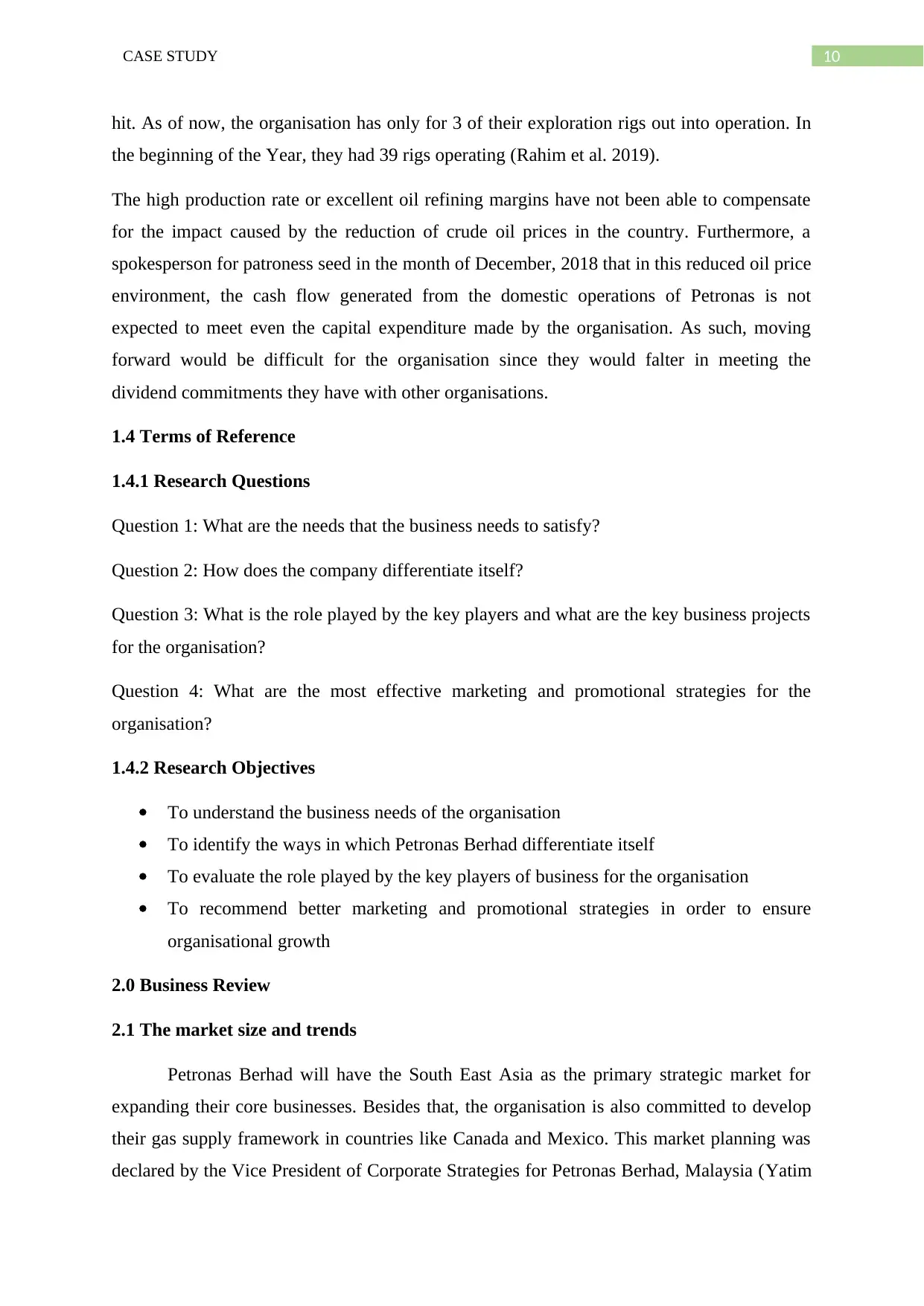
10CASE STUDY
hit. As of now, the organisation has only for 3 of their exploration rigs out into operation. In
the beginning of the Year, they had 39 rigs operating (Rahim et al. 2019).
The high production rate or excellent oil refining margins have not been able to compensate
for the impact caused by the reduction of crude oil prices in the country. Furthermore, a
spokesperson for patroness seed in the month of December, 2018 that in this reduced oil price
environment, the cash flow generated from the domestic operations of Petronas is not
expected to meet even the capital expenditure made by the organisation. As such, moving
forward would be difficult for the organisation since they would falter in meeting the
dividend commitments they have with other organisations.
1.4 Terms of Reference
1.4.1 Research Questions
Question 1: What are the needs that the business needs to satisfy?
Question 2: How does the company differentiate itself?
Question 3: What is the role played by the key players and what are the key business projects
for the organisation?
Question 4: What are the most effective marketing and promotional strategies for the
organisation?
1.4.2 Research Objectives
To understand the business needs of the organisation
To identify the ways in which Petronas Berhad differentiate itself
To evaluate the role played by the key players of business for the organisation
To recommend better marketing and promotional strategies in order to ensure
organisational growth
2.0 Business Review
2.1 The market size and trends
Petronas Berhad will have the South East Asia as the primary strategic market for
expanding their core businesses. Besides that, the organisation is also committed to develop
their gas supply framework in countries like Canada and Mexico. This market planning was
declared by the Vice President of Corporate Strategies for Petronas Berhad, Malaysia (Yatim
hit. As of now, the organisation has only for 3 of their exploration rigs out into operation. In
the beginning of the Year, they had 39 rigs operating (Rahim et al. 2019).
The high production rate or excellent oil refining margins have not been able to compensate
for the impact caused by the reduction of crude oil prices in the country. Furthermore, a
spokesperson for patroness seed in the month of December, 2018 that in this reduced oil price
environment, the cash flow generated from the domestic operations of Petronas is not
expected to meet even the capital expenditure made by the organisation. As such, moving
forward would be difficult for the organisation since they would falter in meeting the
dividend commitments they have with other organisations.
1.4 Terms of Reference
1.4.1 Research Questions
Question 1: What are the needs that the business needs to satisfy?
Question 2: How does the company differentiate itself?
Question 3: What is the role played by the key players and what are the key business projects
for the organisation?
Question 4: What are the most effective marketing and promotional strategies for the
organisation?
1.4.2 Research Objectives
To understand the business needs of the organisation
To identify the ways in which Petronas Berhad differentiate itself
To evaluate the role played by the key players of business for the organisation
To recommend better marketing and promotional strategies in order to ensure
organisational growth
2.0 Business Review
2.1 The market size and trends
Petronas Berhad will have the South East Asia as the primary strategic market for
expanding their core businesses. Besides that, the organisation is also committed to develop
their gas supply framework in countries like Canada and Mexico. This market planning was
declared by the Vice President of Corporate Strategies for Petronas Berhad, Malaysia (Yatim
Paraphrase This Document
Need a fresh take? Get an instant paraphrase of this document with our AI Paraphraser
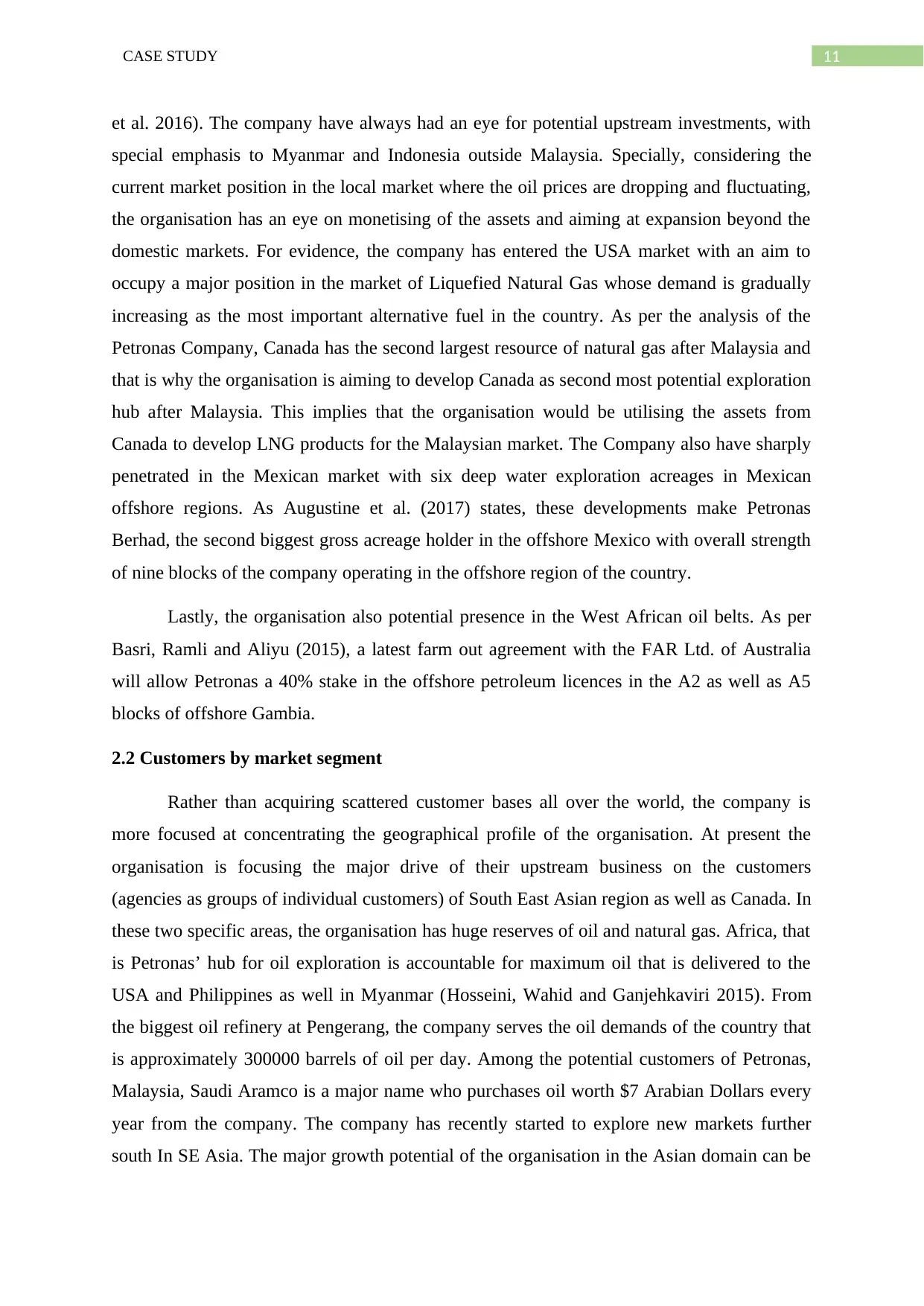
11CASE STUDY
et al. 2016). The company have always had an eye for potential upstream investments, with
special emphasis to Myanmar and Indonesia outside Malaysia. Specially, considering the
current market position in the local market where the oil prices are dropping and fluctuating,
the organisation has an eye on monetising of the assets and aiming at expansion beyond the
domestic markets. For evidence, the company has entered the USA market with an aim to
occupy a major position in the market of Liquefied Natural Gas whose demand is gradually
increasing as the most important alternative fuel in the country. As per the analysis of the
Petronas Company, Canada has the second largest resource of natural gas after Malaysia and
that is why the organisation is aiming to develop Canada as second most potential exploration
hub after Malaysia. This implies that the organisation would be utilising the assets from
Canada to develop LNG products for the Malaysian market. The Company also have sharply
penetrated in the Mexican market with six deep water exploration acreages in Mexican
offshore regions. As Augustine et al. (2017) states, these developments make Petronas
Berhad, the second biggest gross acreage holder in the offshore Mexico with overall strength
of nine blocks of the company operating in the offshore region of the country.
Lastly, the organisation also potential presence in the West African oil belts. As per
Basri, Ramli and Aliyu (2015), a latest farm out agreement with the FAR Ltd. of Australia
will allow Petronas a 40% stake in the offshore petroleum licences in the A2 as well as A5
blocks of offshore Gambia.
2.2 Customers by market segment
Rather than acquiring scattered customer bases all over the world, the company is
more focused at concentrating the geographical profile of the organisation. At present the
organisation is focusing the major drive of their upstream business on the customers
(agencies as groups of individual customers) of South East Asian region as well as Canada. In
these two specific areas, the organisation has huge reserves of oil and natural gas. Africa, that
is Petronas’ hub for oil exploration is accountable for maximum oil that is delivered to the
USA and Philippines as well in Myanmar (Hosseini, Wahid and Ganjehkaviri 2015). From
the biggest oil refinery at Pengerang, the company serves the oil demands of the country that
is approximately 300000 barrels of oil per day. Among the potential customers of Petronas,
Malaysia, Saudi Aramco is a major name who purchases oil worth $7 Arabian Dollars every
year from the company. The company has recently started to explore new markets further
south In SE Asia. The major growth potential of the organisation in the Asian domain can be
et al. 2016). The company have always had an eye for potential upstream investments, with
special emphasis to Myanmar and Indonesia outside Malaysia. Specially, considering the
current market position in the local market where the oil prices are dropping and fluctuating,
the organisation has an eye on monetising of the assets and aiming at expansion beyond the
domestic markets. For evidence, the company has entered the USA market with an aim to
occupy a major position in the market of Liquefied Natural Gas whose demand is gradually
increasing as the most important alternative fuel in the country. As per the analysis of the
Petronas Company, Canada has the second largest resource of natural gas after Malaysia and
that is why the organisation is aiming to develop Canada as second most potential exploration
hub after Malaysia. This implies that the organisation would be utilising the assets from
Canada to develop LNG products for the Malaysian market. The Company also have sharply
penetrated in the Mexican market with six deep water exploration acreages in Mexican
offshore regions. As Augustine et al. (2017) states, these developments make Petronas
Berhad, the second biggest gross acreage holder in the offshore Mexico with overall strength
of nine blocks of the company operating in the offshore region of the country.
Lastly, the organisation also potential presence in the West African oil belts. As per
Basri, Ramli and Aliyu (2015), a latest farm out agreement with the FAR Ltd. of Australia
will allow Petronas a 40% stake in the offshore petroleum licences in the A2 as well as A5
blocks of offshore Gambia.
2.2 Customers by market segment
Rather than acquiring scattered customer bases all over the world, the company is
more focused at concentrating the geographical profile of the organisation. At present the
organisation is focusing the major drive of their upstream business on the customers
(agencies as groups of individual customers) of South East Asian region as well as Canada. In
these two specific areas, the organisation has huge reserves of oil and natural gas. Africa, that
is Petronas’ hub for oil exploration is accountable for maximum oil that is delivered to the
USA and Philippines as well in Myanmar (Hosseini, Wahid and Ganjehkaviri 2015). From
the biggest oil refinery at Pengerang, the company serves the oil demands of the country that
is approximately 300000 barrels of oil per day. Among the potential customers of Petronas,
Malaysia, Saudi Aramco is a major name who purchases oil worth $7 Arabian Dollars every
year from the company. The company has recently started to explore new markets further
south In SE Asia. The major growth potential of the organisation in the Asian domain can be
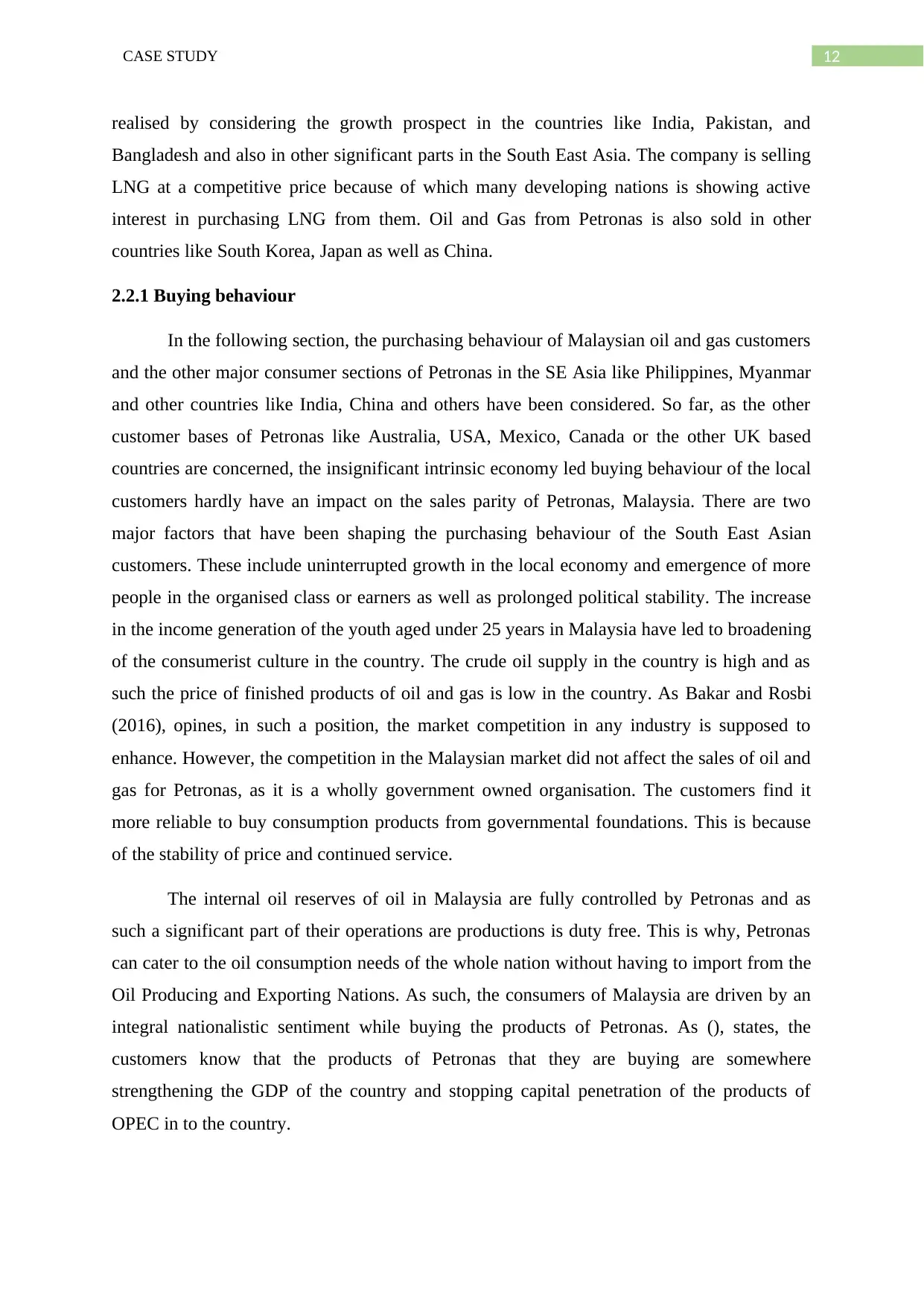
12CASE STUDY
realised by considering the growth prospect in the countries like India, Pakistan, and
Bangladesh and also in other significant parts in the South East Asia. The company is selling
LNG at a competitive price because of which many developing nations is showing active
interest in purchasing LNG from them. Oil and Gas from Petronas is also sold in other
countries like South Korea, Japan as well as China.
2.2.1 Buying behaviour
In the following section, the purchasing behaviour of Malaysian oil and gas customers
and the other major consumer sections of Petronas in the SE Asia like Philippines, Myanmar
and other countries like India, China and others have been considered. So far, as the other
customer bases of Petronas like Australia, USA, Mexico, Canada or the other UK based
countries are concerned, the insignificant intrinsic economy led buying behaviour of the local
customers hardly have an impact on the sales parity of Petronas, Malaysia. There are two
major factors that have been shaping the purchasing behaviour of the South East Asian
customers. These include uninterrupted growth in the local economy and emergence of more
people in the organised class or earners as well as prolonged political stability. The increase
in the income generation of the youth aged under 25 years in Malaysia have led to broadening
of the consumerist culture in the country. The crude oil supply in the country is high and as
such the price of finished products of oil and gas is low in the country. As Bakar and Rosbi
(2016), opines, in such a position, the market competition in any industry is supposed to
enhance. However, the competition in the Malaysian market did not affect the sales of oil and
gas for Petronas, as it is a wholly government owned organisation. The customers find it
more reliable to buy consumption products from governmental foundations. This is because
of the stability of price and continued service.
The internal oil reserves of oil in Malaysia are fully controlled by Petronas and as
such a significant part of their operations are productions is duty free. This is why, Petronas
can cater to the oil consumption needs of the whole nation without having to import from the
Oil Producing and Exporting Nations. As such, the consumers of Malaysia are driven by an
integral nationalistic sentiment while buying the products of Petronas. As (), states, the
customers know that the products of Petronas that they are buying are somewhere
strengthening the GDP of the country and stopping capital penetration of the products of
OPEC in to the country.
realised by considering the growth prospect in the countries like India, Pakistan, and
Bangladesh and also in other significant parts in the South East Asia. The company is selling
LNG at a competitive price because of which many developing nations is showing active
interest in purchasing LNG from them. Oil and Gas from Petronas is also sold in other
countries like South Korea, Japan as well as China.
2.2.1 Buying behaviour
In the following section, the purchasing behaviour of Malaysian oil and gas customers
and the other major consumer sections of Petronas in the SE Asia like Philippines, Myanmar
and other countries like India, China and others have been considered. So far, as the other
customer bases of Petronas like Australia, USA, Mexico, Canada or the other UK based
countries are concerned, the insignificant intrinsic economy led buying behaviour of the local
customers hardly have an impact on the sales parity of Petronas, Malaysia. There are two
major factors that have been shaping the purchasing behaviour of the South East Asian
customers. These include uninterrupted growth in the local economy and emergence of more
people in the organised class or earners as well as prolonged political stability. The increase
in the income generation of the youth aged under 25 years in Malaysia have led to broadening
of the consumerist culture in the country. The crude oil supply in the country is high and as
such the price of finished products of oil and gas is low in the country. As Bakar and Rosbi
(2016), opines, in such a position, the market competition in any industry is supposed to
enhance. However, the competition in the Malaysian market did not affect the sales of oil and
gas for Petronas, as it is a wholly government owned organisation. The customers find it
more reliable to buy consumption products from governmental foundations. This is because
of the stability of price and continued service.
The internal oil reserves of oil in Malaysia are fully controlled by Petronas and as
such a significant part of their operations are productions is duty free. This is why, Petronas
can cater to the oil consumption needs of the whole nation without having to import from the
Oil Producing and Exporting Nations. As such, the consumers of Malaysia are driven by an
integral nationalistic sentiment while buying the products of Petronas. As (), states, the
customers know that the products of Petronas that they are buying are somewhere
strengthening the GDP of the country and stopping capital penetration of the products of
OPEC in to the country.
⊘ This is a preview!⊘
Do you want full access?
Subscribe today to unlock all pages.

Trusted by 1+ million students worldwide
1 out of 63
Related Documents
Your All-in-One AI-Powered Toolkit for Academic Success.
+13062052269
info@desklib.com
Available 24*7 on WhatsApp / Email
![[object Object]](/_next/static/media/star-bottom.7253800d.svg)
Unlock your academic potential
Copyright © 2020–2025 A2Z Services. All Rights Reserved. Developed and managed by ZUCOL.





